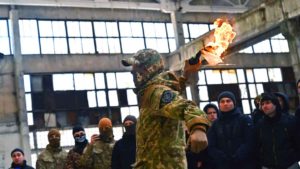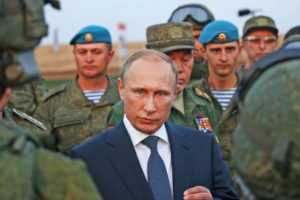More than 100 days on, the fate of Russia’s campaign to capture the entirety of the Luhansk region still hangs in the balance. If the whole Luhansk region falls, the rest of Ukraine’s east may very likely follow. Both the Russian and Ukrainian forces have committed their forces here for strategic reasons — the territory is critical for a continued Russian advance in the direction of cities such as Dnipro. President Zelenskyy understands this, which is why he made an unannounced visit to Lysychansk at the weekend.
The last uncontested town in the region still controlled by Zelenskyy’s forces, Lysychansk is now a crucial base for the Ukrainian artillery: it is within shooting range of the strategically critical town of Severodonetsk, where the Ukrainians are making a valiant stand against Russian forces. The Kremlin has made clear its strategic need to capture the industrial town: while military operations in other fronts have ground to a halt, vast material and reserve troop formations, as well as concentrated artillery strikes, have been thrown against Severodonetsk.
Lysychansk is within striking range of Russian artillery and is therefore hardly a secure area for the Ukrainian President to visit: a senior Russian general in command of that sector was reported to have been killed by the Ukrainians merely a few miles away from the garrison over the weekend. If anything, the continued attrition of senior Russian command staff is as remarkable as the presence of a commander-in-chief in the middle of the war theatre. To paraphrase Oscar Wilde: To lose a general in battle is surely a misfortune; but lose a general in battle every single week over the course of 14 weeks, and it starts to look like carelessness.
After Russian forces occupied most of Severodonetsk, the Ukrainians attempted a surprise counterattack with fresh reserves and foreign volunteer battalions. The last three days have seen various parts of the town including its centre and industrial zone change hands several times. Public statements have been contradictory but the governor of the region claims Ukraine still controls at least parts of Severodonetsk. Indeed, much of the pro-Kyiv commentariat has framed the counterattack as a cunning trap set to lure remnants of Russian troops reserves out from beneath the cover of their artillery support. Large swathes of the town seem to have changed hands over the 24 hours on several occasions.
The confusion over the Ukrainian offensive — and whether it may have been organised to coincide with the presidential visit — illustrates just how difficult it is to understand the fluidly evolving battle zone. This is true even in the age of Telegram and Twitter, though Ukrainian troops in Severodonetsk have told me that the fighting is fierce and there have been tremendous casualties on both sides. Video footage of pro-Russian separatists shows them being equipped with Soviet-era helmets and bolt-action rifles from the Second World War. By all accounts, the centre of Severodonetsk is now a no man’s land and even when I visited Lysychansk a month ago — before the latest round of fighting — the residents had already mostly fled. Both towns are now unliveable.
In the long term, the churn of the incremental battle for eastern Ukraine also signals how the Kremlin has recalibrated its approach to the war. Its hapless early performance and disastrous decision-making has taken its toll, and the Russian high command has implicitly acknowledged that it had overstretched its forces and pulled back from the north of the country in order to concentrate assaults in the south and east. The Russian military advances have withdrawn from Kherson and Zhaporozhia, as well as from the city of Kharkiv.
The Kremlin has now pivoted towards outlasting Kyiv in a prolonged war of attrition. Faced with a concentrated Russian counterattack around the Severodonetsk salient, the optimistic narrative surrounding Ukraine’s resistance has started to slip away. This sense of exhaustion arose from a number of battlefield reversals. President Putin — despite the rampant and unverified speculations about the state of his health — seems to have doubled down on the idea that Russia can weather its international sanctions regime while methodically ratcheting up existing divides within the Western Alliance.
The recent Russian rocket attacks on an important grain silo in Mykolaiv, the systematic theft of grain stocks and the doomed negotiations over the possibility of its export through so-called humanitarian corridors all illustrate the future of the Russian strategy. Moscow hopes to disrupt global supply chains, create artificial famines and crank up energy prices across Europe and Africa. The next phase of its war seems to be just getting started.
Meanwhile, the widespread fantasies of an economically-driven Russian popular uprising, a palace coup in the Kremlin or the shuffling of the Russian Presidency by Russian elites show no sign of manifesting. As the slow grind in Luhansk indicates, the Ukrainians are in for a long and painful conflict of incremental losses and victories. The first 100 days of the war are over — they won’t be the last.
Disclaimer
Some of the posts we share are controversial and we do not necessarily agree with them in the whole extend. Sometimes we agree with the content or part of it but we do not agree with the narration or language. Nevertheless we find them somehow interesting, valuable and/or informative or we share them, because we strongly believe in freedom of speech, free press and journalism. We strongly encourage you to have a critical approach to all the content, do your own research and analysis to build your own opinion.
We would be glad to have your feedback.
Source: UnHerd Read the original article here: https://unherd.com



